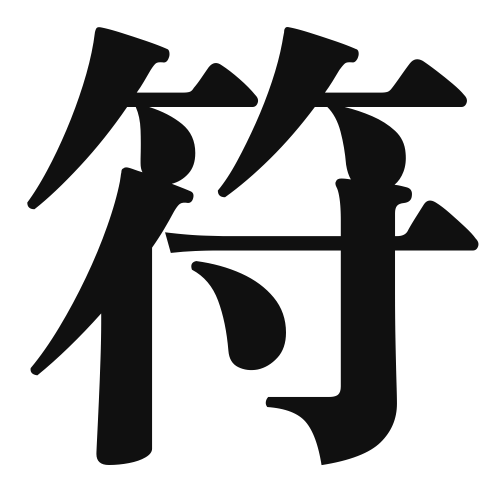1. Overview of Meaning
The kanji “符” (fu) generally means “sign,” “token,” or “symbol.” It is often used to represent something that indicates or signifies another thing, such as a mark or a character that conveys meaning.
2. Formation and Radical
Formation of the Kanji: The kanji “符” is classified as a phonetic-ideographic character (形声文字), which combines a meaning component and a phonetic component. The left part “竹” (bamboo) suggests a connection to writing or recording, while the right part “付” (to attach) indicates the act of marking or signifying.
Radical: The radical for “符” is “竹” (bamboo), which is often associated with writing instruments, reflecting its use in written symbols.
3. Examples of Usage
Common Words and Phrases: Some frequently used words that include “符” are:
- 符号 (ふごう, fugou) – symbol
- 符牒 (ふちょう, fuchou) – code or cipher
Example Sentences in Daily Conversation:
- この符号は何を意味していますか? (このふごうはなにをいみしていますか?) – What does this symbol mean?
- 彼は秘密の符牒を使っています。 (かれはひみつのふちょうをつかっています。) – He is using a secret code.
4. Synonyms and Antonyms
Similar Kanji: A similar kanji is “印” (いん, in), which also means “mark” or “seal.” However, “印” often refers to a physical mark or stamp, while “符” emphasizes the symbolic or indicative aspect.
Antonyms: An antonym for “符” could be “無” (む, mu), meaning “none” or “without,” as it represents the absence of a sign or symbol.
5. Cultural and Historical Background
Connection to Japanese Culture: In Japanese culture, “符” is often associated with traditional practices such as calligraphy and the creation of talismans, which are believed to carry protective symbols.
Proverbs and Idioms: One common idiom is “符を持つ” (ふをもつ, fu wo motsu), which means “to hold a sign,” often used to indicate having a clear understanding or indication of something.
